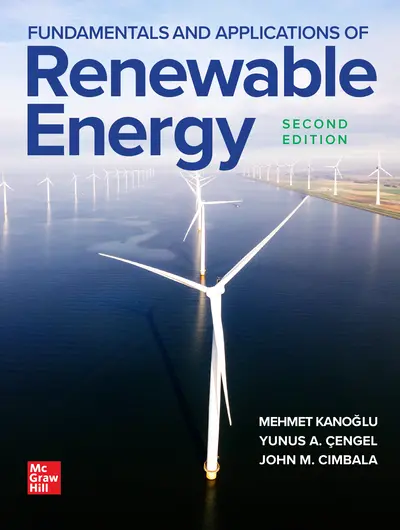My Account Details

ISBN10: 126507965X | ISBN13: 9781265079659

Step 1 . Download Adobe Digital Editions to your PC or Mac desktop/laptop.
Step 2. Register and authorize your Adobe ID (optional). To access your eBook on multiple devices, first create an Adobe ID at account.adobe.com. Then, open Adobe Digital Editions, go to the Help menu, and select "Authorize Computer" to link your Adobe ID.
Step 3. Open Your eBook. Use Adobe Digital Editions to open the file. If the eBook doesn’t open, contact customer service for assistance.
Renewable energy principles and practices—fully updated for the latest advances
Written by a team of recognized experts, this thoroughly revised guide offers comprehensive coverage of all major renewable energy sources, including solar, wind, hydropower, geothermal, and biomass. This new edition keeps up to date with the rapid changes in renewable energy technology. Readers will get worked-out example problems and end-of-chapter review questions that help to reinforce important concepts.
By stressing real-world relevancy and practical uses, Fundamentals and Applications of Renewable Energy, Second Edition prepares students for a successful career in renewable energy. Readers will get detailed discussions on the thermodynamics, heat transfer, and fluid mechanics aspects of renewable energy systems as well as economic and environmental considerations. The book features new sections on solar thermal applications, photovoltaics, wind power and biomass energy.
- Features both technical and economic analyses of renewable systems
- Approximately 1100 end-of-chapter problems including conceptual and multiple-choice questions
- Supplements include a complete PDF solutions manual and PowerPoint lecture slides
- Written by a team of renewable energy educators and experienced authors
Preface
Chapter 1. Introduction to Renewable Energy
1-1 Why Renewable Energy?
1-2 Dimensions and Units
1-3 Fossil Fuels and Nuclear Energy
References
Problems
Chapter 2. A Review of Thermal Sciences
2-1 Thermal Sciences
2-2 Thermodynamics
2-3 Heat Transfer
2-4 Fluid Mechanics
2-5 Thermochemistry
2-6 Heat Engines and Power Plants
2-7 Refrigerators and Heat Pumps
References
Problems
Chapter 3. Fundamentals of Solar Energy
3-1 Introduction
3-2 Radiation Fundamentals
3-3 Radiative Properties
3-4 Solar Radiation
3-5 Estimation of Solar Radiation
References
Problems
Chapter 4. Solar Energy Applications
4-1 Introduction
4-2 Flat-Plate Solar Collector
4-3 Evacuated Tube Collectors
4-4 Concentrating Solar Collector
4-5 Solar-Power-Tower Plant
4-6 Solar Pond
4-7 Passive Solar Applications
References
Problems
Chapter 5. Solar Photovoltaic Systems
5-1 Photovoltaic Effect
5-2 Analysis of Solar Cells
5-3 Photovoltaic Technologies and Systems
5-4 Energy Production from Photovoltaic Systems
5-5 Photovoltaic System Configurations
5-6 Components of Photovoltaic Power Systems
References
Problems
Chapter 6. Wind Energy
6-1 Introduction
6-2 Wind Turbine Types and Power Performance Curve
6-3 Wind Turbine Operation and Aerodynamics
6-4 Wind Power Potential
6-5 Wind Power Density
6-6 Wind Turbine Efficiency
6-7 Electricity Production from Wind Turbines
6-8 Wind Power Costing
6-9 Considerations in Wind Power Applications
References
Problems
Chapter 7. Hydropower
7-1 Introduction
7-2 Analysis of a Hydroelectric Power Plant
7-3 Impulse Turbines
7-4 Reaction Turbines
7-5 Turbine Specific Speed
7-6 Run-of-River Plants and Waterwheels
References
Problems
Chapter 8. Geothermal Energy
8-1 Introduction
8-2 Geothermal Applications
8-3 Geothermal Heating
8-4 Geothermal Cooling
8-5 Geothermal Heat Pump Systems
8-6 Geothermal Power Production
8-7 Geothermal Cogeneration
References
Problems
Chapter 9. Biomass Energy
9-1 Biomass Resources
9-2 Conversion of Biomass to Biofuel
9-3 Anaerobic Digestion
9-4 Thermal Gasification
9-5 Ethanol
9-6 Biodiesel
9-7 Liquid Fuels from Syngas, Pyrolysis Oil, and Biocrude
9-8 Electricity and Heat Production by Biomass
9-9 Municipal Solid Waste
References
Problems
Chapter 10. Ocean Energy
10-1 Introduction
10-2 Ocean Thermal Energy Conversion
10-3 Wave Energy
10-4 Tidal Energy
References
Problems
Chapter 11. Hydrogen and Fuel Cells
11-1 Hydrogen: An Energy Carrier
11-2 Fuel Cells
References
Problems
Chapter 12. Economics of Renewable Energy
12-1 Engineering Economics
12-2 The Time Value of Money
12-3 Life Cycle Cost Analysis
12-4 Payback Period Analysis
References
Problems
Chapter 13. Energy and the Environment
13-1 Introduction
13-2 Air Pollutants
13-3 Emissions from Automobiles
13-4 The Greenhouse Effect
13-5 Stratospheric Ozone Depletion
13-6 Nuclear Waste
References
Problems
Appendix 1. Property Tables (SI Units)
Appendix 2. Property Tables (English Units)
Index
Need support? We're here to help - Get real-world support and resources every step of the way.